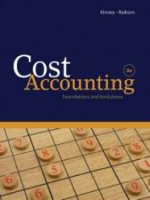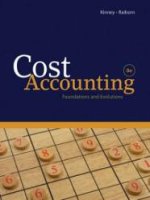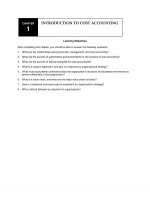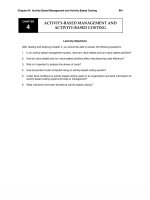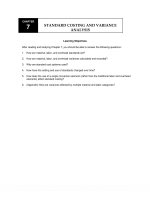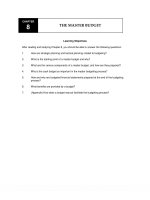Solution manual cost accounting 8th by kinney chapter 01
Bạn đang xem bản rút gọn của tài liệu. Xem và tải ngay bản đầy đủ của tài liệu tại đây (308.23 KB, 14 trang )
To download more slides, ebook, solutions and test bank, visit
CHAPTER
INTRODUCTION TO COST ACCOUNTING
1
Learning Objectives
After completing this chapter, you should be able to answer the following questions:
1. What are the relationships among financial, management, and cost accounting?
2. What are the sources of authoritative pronouncements for the practice of cost accounting?
3. What are the sources of ethical standards for cost accountants?
4. What is a mission statement, and why is it important to organizational strategy?
5. What must accountants understand about an organization’s structure and business environment to
perform effectively in that organization?
6. What is a value chain, and what are the major value chain functions?
7. How is a balanced scorecard used to implement an organization’s strategy?
8. Why is ethical behavior so important in organizations?
©2011 Cengage Learning. All Rights Reserved. SM Cost Accounting 8th Edition by Raiborn and Kinney.
Visit to download more slides, ebooks, solution manual, and test bank.
To download more slides, ebook, solutions and test bank, visit
Chapter 01: Introduction to Cost Accounting
IM 2
Terminology
Authority: The right (usually by virtue of position or rank) to use resources to accomplish a task or
achieve an objective
Balanced scorecard: A framework that restates an organization’s strategy into clear and objective
performance measures focused on customers, internal business processes, employees, and
shareholders
Competence: Professional ethics standard that requires professionals to develop and maintain the skills
needed to practice their profession
Confidentiality: Professional ethics standard that requires professionals to refrain from disclosing
company information to inappropriate parties (such as competitors)
Core competency: Any critical function or activity in which an organization seeks a higher proficiency
than its competitors, making it the root of competitiveness and competitive advantage
Cost accounting: A discipline that addresses the demands of both financial and management
accounting by providing product cost information to (1) external parties (stockholders, creditors, and
various regulatory bodies) for investment and credit decisions and (2) internal managers who are
responsible for planning, controlling, decision making, and evaluation of performance
Cost leadership: A company’s ability to maintain its competitive advantage by undercutting competitor
prices
Credibility: Professional ethics standard that requires individuals to provide full, fair, and timely
disclosure of all relevant information in a given situation
Customer value perspective: The balanced scorecard perspective that addresses how well the
organization is doing relative to important customer criteria such as speed (lead time), quality, service,
and price (both purchase and after purchase)
Downstream cost: Costs such as marketing, distribution, and customer service which are typically
incurred after production of the product as opposed to upstream costs of research and development and
product design
Earnings management: The act of using accounting methods or practices to deliberately “adjust” a
company’s profit amount to meet a predetermined internal or external target
Environmental constraint: any limitation caused by external cultural, fiscal (such as taxation structures),
legal/regulatory, or political situations and by the competitive market structures that cannot be directly
controlled by management
Financial performance perspective: The balanced scorecard perspective that addresses the concerns
of stockholders and other stakeholders about profitability and organizational growth
Integrity: Professional ethics standard that prohibits individuals from participating in activities that would
discredit their company or profession
Intellectual capital: All of the intangible assets contained in an organization, including knowledge, skills,
and information tha��������������������������������������������������������������������������������������������������������������������������������������������������������������������������������������������������������������������������������������������������������������������������������������������������������������������������������������������������������������������������������������������������������������������������������������������������������������������������������������������������������������������������������������������������������������������������������������������������������������������������������������������������������������������������������������������������������������������������������������������������������������������������������������������������������������������������������������������������������������������������������������������������������������������������������������������������������������������������������������������������������������������������������������������������������������������������������������������������������������������������������������������������������������������������������������������������������������������������������������������������������������������������������������������������������������������������������������������������������������������������������������������������������������������������������������������������������������������������������������������������������������������������������������������������������������������������������������������������������������������������������������������������������������������������������������������������������������������������������������������������������������������������������������������������������������������������������������������������������������������������������������������������������������������������������������������������������������������������������������������������������������������������������������������������������������������������������������������������������������������������������������������������������������������������������������������������������������������������������������������������������������������������������������������������������������������������������������������������������������������������������������������������������������������������������������������������������������������������������������������������������������������������������������������������������������������������������������������������������������������������������������������������������������������������������������������������������������������������������������������������������������������������������������������������������������������������������������������������������������������������������������������������������������������������������������������������������������������������������������������������������������������������������������������������������������������������������������������������������������������������������������������������������������������������������������������������������������������������������������������������������������������������������������������������������������������������������������������������������������������������������������������������������������������������������������������������������������������������������������������������������������������������������������������������������������������������������������������������������������������������������������������������������������������������������������������������������������������������������������������������������������������������������������������������������������������������������������������������������������������������������������������������������������������������������������������������������������������������������������������������������������������������������������������������������������������������������������������������������������������������������������������������������������������������������������������������������������������������������������������������������������������������������������������������������������������������������������������������������������������������������������������������������������������������������������������������������������������������������������������������������������������������������������������������������������������������������������������������������������������������������������������������������������������������������������������������������������������������������������������������������������������������������������������������������������������������������������������������������������������������������������������������������������������������������������������������������������������������������������������������������������������������������������������������������������������������������������������������������������������������������������������������������������������������������������������������������������������������������������������������������������������������������������������������������������������������������������������������������������������������������������������������������������������������������������������������������������������������������������������������������������������������������������������������������������������������������������������������������������������������������������������������������������������������������������������������������������������������������������������������������������������������������������������������������������������������������������������������������������������������������������������������������������������������������������������������������������������������������������������������������������������������������������������������������������������������������������������������������������������������������������������������������������������������������������������������������������������������������������������������������������������������������������������������������������������������������������������������������������������������������������������������������������������������������������������������������������������������������������������������������������������������������������������������������������������������������������������������������������������������������������������������������������������������������������������������������������������������������������������������������������������������������������������������������������������������������������������������������������������������������������������������������������������������������������������������������������������������������������������������������������������������������������������������������������������������������������������������������������������������������������������������������������������������������������������������������������������������������������������������������������������������������������������������������������������������������������������������������������������������������������������������������������������������������������������������������������������������������������������������������������������������������������������������������������������������������������������������������������������������������������������������������������������������������������������������������������������������������������������������������������������������������������������������������������������������������������������������������������������������������������������������������������������������������������������������������������������������������������������������������������������������������������������������������������������������������������������������������������������������������������������������������������������������������������������������������������������������������������������������������������������������������������������������������������������������������������������������������������������������������������������������������������������������������������������������������������������������������������������������������������������������������������������������������������������������������������������������������������������������������������������������������������������������������������������������������������������������������������������������������������������������������������������������������������������������������������������������������������������������������������������������������������������������������������������������������������������������������������������������������������������������������������������������������������������������������������������������������������������������������������������������������������������������������������������������������������������������������������������������������������������������������������������������������������������������������������������������������������������������������������������������������������������������������������������������������������������������������������������������������������������������������������������������������������������������������������������������������������������������������������������������������������������������������������������������������������������������������������������������������������������������������������������������������������������������������������������������������������������������������������������������������������������������������������������������������������������������������������������������������������������������������������������������������������������������������������������������������������������������������������������������������������������������������������������������������������������������������������������������������������������������������������������������������������������������������������������������������������������������������������������������������������������������������������������������������������������������������������������������������������������������������������������������������������������������������������������������������������������������������������������������������������������������������������������������������������������������������������������������������������������������������������������������������������������������������������������������������������������������������������������������������������������������������������������������������������������������������������������������������������������������������������������������������������������������������������������������������������������������������������������������������������������������������������������������������������������������������������������������������������������������������������������������������������������������������������������������������������������������������������������������������������������������������������������������������������������������������������������������������������������������������������������������������������������������������������������������������������������������������������������������������������������������������������������������������������������������������������������������������������������������������������������������������������������������������������������������������������������������������������������������������������������������������������������������������������������������������������������������������������������������������������������������������������������������������������������������������������������������������������������������������������������������������������������������������������������������������������������������������������������������������������������������������������������������������������������������������������������������������������������������������������������������������������������������������������������������������������������������������������������������������������������������������������������������������������������������������������������������������������������������������������������������������������������������������������������������������������������������������������������������������������������������������������������������������������������������������������������������������������������������������������������������������������������������������������������������������������������������������������������������������������������������������������������������������������������������������������������������������������������������������������������������������������������������������������������������������������������������������������������������������������������������������������������������������������������������������������������������������������������������������������������������������������������������������������������������������������������������������������������������������������������������������������������������������������������������������������������������������������������������������������������������������������������������������������������������������������������������������������������������������������������������������������������������������������������������������������������������������������������������������������������������������������������������������������������������������������������������������������������������������������������������������������������������������������������������������������������������������������������������������������������������������������������������������������������������������������������������������������������������������������������������������������������������������������������������������������������������������������������������������������������������������������������������������������������������������������������������������������������������������������������������������������������������������������������������������������������������������������������������������������������������������������������������������������������������������������������������������������������������������������������������������������������������������������������������������������������������������������������������������������������������������������������������������������������������������������������������������������������������������������������������������������������������������������������������������������������������������������������������������������������������������������������������������������������������������������������������������������������������������������������������������������������������������������������������������������������������������������������������������������������������������������������������������������������������������������������������������������������������������������������������������������������������������������������������������������������������������������������������������������������������������������������������������������������������������������������������������������������������������������������������������������������������������������������������������������������������������������������������������������������������������������������������������������������������������������������������������������������������������������������������������������������������������������������������������������������������������������������������������������������������������������������������������������������������������������������������������������������������������������������������������������������������������������������������������������������������������������������������������������������������������������������������������������������������������������������������������������������������������������������������������������������������������������������������������������������������������������������������������������������������������������������������������������������������������������������������������������������������������������������������������������������������������������������������������������������������������������������������������������������������������������������������������������������������������������������������������������������������������������������������������������������������������������������������������������������������������������������������������������������������������������������������������������������������������������������������������������������������������������������������������������������������������������������������������������������������������������������������������������������������������������������������������������������������������������������������������������������������������������������������������������������������������������������������������������������������������������������������������������������������������������������������������������������������������������������������������������������������������������������������������������������������������������������������������������������������������������������������������������������������������������������������������������������������������������������������������������������������������������������������������������������������������������������������������������������������������������������������������������������������������������������������������������������������������������������������������������������������������������������������������������������������������������������������������������������������������������������������������������������������������������������������������������������������������������������������������������������������������������������������������������������������������������������������������������������������������������������������������������������������������������������������������������������������������������������������������������������������������������������������������������������������������������������������������������������������������������������������������������������������������������������������������������������������������������������������������������������������������������������������������������������������������������������������������������������������������������������������������������������������������������������������������������������������������������������������������������������������������������������������������������������������������������������������������������������������������������������������������������������������������������������������������������������������������������������������������������������������������������������������������������������������������������������������������������������������������������������������������������������������������������������������������������������������������������������������������������������������������������������������������������������������������������������������������������������������������������������������������������������������������������������������������������������������������������������������������������������������������������������������������������������������������������������������������������������������������������������������������������������������������������������������������������������������������������������������������������������������������������������������������������������������������������������������������������������������������������������������������������������������������������������������������������������������������������������������������������������������������������������������������������������������������������������������������������������������������������������������������������������������������������������������������������������������������������������������������������������������������������������������������������������������������������������������������������������������������������������������������������������������������������������������������������������������������������������������������������������������������������������������������������������������������������������������������������������������������������������������������������������������������������������������������������������������������������������������������������������������������������������������������������������������������ue chain so that the strategy can be effectively implemented.
©2011 Cengage Learning. All Rights Reserved. SM Cost Accounting 8th Edition by Raiborn and Kinney.
Visit to download more slides, ebooks, solution manual, and test bank.
To download more slides, ebook, solutions and test bank, visit
Chapter 01: Introduction to Cost Accounting
IM 10
LO.7 How is a balanced scorecard used to implement an organization’s strategy?
H. Balanced Scorecard
1. Firms use a portfolio of lag and lead indicators to determine not only how the organization has
performed in the past but also how it is likely to perform in the future.
a. Lag indicators which are historical financial data that reflect outcomes that have resulted
from past actions, such as installing a new production process or implementing a new
software system, are often recognized and assessed too late to significantly improve current
or future actions.
b. Lead indicators which reflect future financial and nonfinancial outcomes (including
opportunities and problems) help managers assess strategic progress and guide decision
making before lag indicators are known.
2. Organizations often use both lead and lag indicators in a balanced scorecard to assess strategy
congruence.
3. The balanced scorecard (BSC) is a framework that restates an organization’s strategy into clear
and objective performance measures focused on customers, internal business processes,
employees, and shareholders.
4. The BSC includes long-term and short-term, internal and external, financial and nonfinancial
measures to balance management’s view and execution of strategy.
5. As illustrated in text Exhibit 1–8 (p. 13), the balanced scorecard has four perspectives:
a. The learning and growth perspective focuses on using the organization’s intellectual
capital to adapt to changing customer needs or to influence new customers’ needs and
expectations through product or service innovations.
b. The internal business perspective focuses on those things that the organization needs to
do well to meet customer needs and expectations.
c.
The customer value perspective addresses how well the organization is doing relative to
important customer criteria such as speed (lead time), quality, service, and price (both
purchase and after purchase).
d. The financial perspective addresses the concerns of stockholders and other stakeholders
about profitability and organizational growth.
6. See text Exhibit 1–9 (p. 14) for a more realistic and more complicated balanced scorecard.
LO.8 Why is ethical behavior so important in organizations?
I.
Ethics in Multinational Corporations
1. Accountants and other individuals working for multinational companies should be aware of not
only their company’s and the IMA’s code of ethical conduct but also the laws and ethical
parameters within countries in which the multinational operates.
2. The Foreign Corrupt Practices Act (FCPA) of 1977 prohibits U.S. corporations from offering or
©2011 Cengage Learning. All Rights Reserved. SM Cost Accounting 8th Edition by Raiborn and Kinney.
Visit to download more slides, ebooks, solution manual, and test bank.
To download more slides, ebook, solutions and test bank, visit
Chapter 01: Introduction to Cost Accounting
IM 11
giving bribes (directly or indirectly) to foreign officials to influence those individuals (or cause them
to use their influence) to help businesses obtain or retain business.
3. The Organization of Economic Cooperation and Development (OECD) has released a document
that makes it a crime to offer, promise or give a bribe to a foreign public official in order to obtain
or retain international business deals.
a. As of March 2008, 37 countries (see Text Exhibit 1–10 (p. 15)) had signed this document,
including the United States.
b. Signing the OECD convention illustrates that companies globally are beginning to
acknowledge that bribery should not be considered an appropriate means of doing business.
©2011 Cengage Learning. All Rights Reserved. SM Cost Accounting 8th Edition by Raiborn and Kinney.
Visit to download more slides, ebooks, solution manual, and test bank.
To download more slides, ebook, solutions and test bank, visit
Chapter 01: Introduction to Cost Accounting
IM 12
Multiple Choice Questions
1. (LO.1) Select the incorrect comparison between financial and management accounting:
a.
b.
c.
d.
Primary focus
Overriding criteria
Information timeframe
Recordkeeping
Financial Accounting
External
Verifiability
Historical
Formal
Management Accounting
Internal
GAAP
Current/future
Formal and informal
2. (LO.1) Oversight of auditing standards for public companies is the responsibility of the
a.
Public Company Accounting Oversight Board.
b.
Securities and Exchange Commission.
c.
Financial Accounting Standards Board.
d.
Institute of Management Accountants.
3, (LO.1) The acronym IASB stands for
a.
Internal Accounting Standards Board.
b.
Internal Auditing Standards Board.
c.
International Auditing Standards Board.
d.
International Accounting Standards Board.
4. (LO.1) Cost accounting can best be described as
a.
the intersection between financial and management accounting.
b.
a system that meets the informational demands of both financial and management
accounting.
c.
a system that provides product cost information to Internal managers for planning,
controlling, decision making and evaluating performance.
d.
all of the above.
5. (LO.2) Statements on Management Accounting (SMA) are directives on the practice of
management and cost accounting. Select the incorrect statement concerning SMAs from the
following.
a.
SMAs are issued by the Cost Accounting Standards Board.
b.
SMAs are not legally binding.
c.
SMAs go through a rigorous developmental and exposure process.
d.
SMAs describe high-quality or best practices in management accounting.
6. (LO.3) A management accountant who fails to perform professional duties in accordance with
relevant standards is acting contrary to which of the following standards?
a.
Competency
b.
Integrity
c.
Objectivity
d.
Confidentiality
7. (LO.3) The IMA Code of Ethics requires a management accountant to follow the established
policies of the organization when facing an ethical conflict. When management accountants fail
to resolve an ethical conflict by talking with their immediate supervisor they should
a.
communicate the problem to authorities outside the organization.
b.
contact the next higher managerial level.
c.
notify the audit committee of the board of directors.
d.
contact the chief financial officer.
©2011 Cengage Learning. All Rights Reserved. SM Cost Accounting 8th Edition by Raiborn and Kinney.
Visit to download more slides, ebooks, solution manual, and test bank.
To download more slides, ebook, solutions and test bank, visit
Chapter 01: Introduction to Cost Accounting
IM 13
8. (LO.3) According to the IMA Code of Ethics a practitioner has the responsibility to recognize
professional limitations. Under which standard of ethical conduct would this responsibility be
included?
a.
Competency
b.
Confidentiality
c.
Integrity
d.
Objectivity
9. (LO.4) Strategic planning includes all of the following except:
a.
top-level management participation.
b.
a long-term focus.
c.
analysis of the current month’s actual variances from budget.
d.
identification of long-term key variables including external influences.
10. (LO.4) The strategy that is being used by a company that seeks to provide superior quality
products or more unique services than its competitors is a
a.
cost leadership strategy.
b.
differentiation strategy.
c.
customer value strategy.
d.
value chain strategy.
11. (LO.5) All of the following are staff personnel except:
a.
production supervisor.
b.
cost accountant.
c.
corporate controller.
d.
tax accountant.
12. (LO.5) An organization’s collection of knowledge, skills, and information is referred to as its
a.
political capital.
b.
qualitative capital.
c.
intangible capital.
d.
intellectual capital.
13. (LO.6) All of the following are examples of upstream functions in the value chain except
a.
supply.
b.
research and development.
c.
production.
d.
design.
14. (LO.7) Which balanced scorecard perspective focuses on those things that the organization must
do well to meet customer needs and expectations?
a.
Customer perspective
b.
Learning and growth perspective
c.
Financial perspective
d.
Internal business perspective
15. (LO.8) Which of the following is a violation of the Foreign Corrupt Practices Act?
a.
Paying cash bribes to foreign officials
b.
Giving sporting event tickets to foreign officials
c.
Providing free samples to the families of foreign officials
d.
All of the above
©2011 Cengage Learning. All Rights Reserved. SM Cost Accounting 8th Edition by Raiborn and Kinney.
Visit to download more slides, ebooks, solution manual, and test bank.
To download more slides, ebook, solutions and test bank, visit
Chapter 01: Introduction to Cost Accounting
IM 14
Multiple Choice Solutions
1.
b
2.
a
3.
d
4.
d
5.
a
6.
a (CMA Adapted)
7.
b (CMA Adapted)
8.
c (CMA Adapted)
9.
c (CMA Adapted)
10.
b
11.
a
12.
d
13.
c
14.
d
15.
d
©2011 Cengage Learning. All Rights Reserved. SM Cost Accounting 8th Edition by Raiborn and Kinney.
Visit to download more slides, ebooks, solution manual, and test bank.
